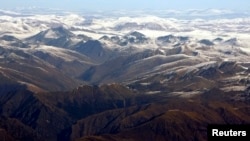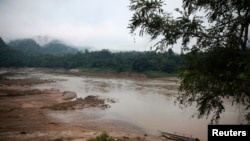With temperatures rising four times faster than anywhere else in Asia, the Tibetan Plateau might soon lose most of its glacier and permafrost, affecting water supplies throughout Asia, Chinese scientists say.
Long known as the “roof of the world,” the Tibetan Plateau is about the size of Western Europe and supplies water to nearly 2 billion people in Asia as the source of several major rivers, including the Yangze, Mekong, Salween (Gyalmo Ngulchu), Indus, Brahmaputra and Yellow rivers.
But because of the impact of climate change, the glaciers are retreating rapidly, grasslands are shrinking as desertification expands, regional precipitation has become irregular, water levels are dropping in major rivers and the permafrost is thawing.
The melting of Tibetan glaciers, the largest mass of frozen fresh water outside the polar regions, is linked to many environmental consequences both locally and globally, including heat waves in Europe, according to some studies.
Glacial retreat
Chinese officials estimate Tibet holds 14.5 percent of the world’s total glacier mass. While there are a few different theories on what is causing the glaciers to melt, researchers agree the pace is staggering.
China's state-run Xinhua news agency reported in April that an average of 247 square kilometers of glacier is disappearing annually, and that some 7,600 square kilometers of glacier, or about 18 percent of the total, has disappeared since the 1950s.
Zhang Mingxing, a Chinese official who heads the Tibet Mountaineering Administration, said the glacier at the Everest base camp, 5,200 meters above sea level, has already disappeared. “There is nothing but stones [left],” he was quoted as saying by Xinhua.
Prior Chinese research of substances within Tibetan glaciers indicated carbon from forest fires, crop burning and domestic cooking stoves from India have caused the melting. While these could be contributing factors, scientists say the global rise in temperatures is indisputably the primary cause.
Tibetans say there has been a drastic change of temperature since 1980s. One U.S.-based Tibetan who recently returned to Lhasa expressed shock at seeing the climatological impact on people’s clothing style. “When I lived in Lhasa, it was very rare that people could walk outside in T-shirts,” said the man, who asked that his name be withheld. “Now people are walking in shorts!”
National Geographic reported in 2010 that one glacier was retreating by about 300 meters a year, the length of a U.S. football field.
As early as 2009, China’s leading scientist on glaciers, Qin Dahe, said glaciers on the Tibetan Plateau were melting faster than in any other part of the world. In the short term, he warned, the melt would trigger more flooding and mudslides; in the long term: "water supplies in the region will be in peril.”
Some researchers have predicted that most of the Himalayan glaciers will be gone in 20 years.
Water needs
Those shrinking glaciers feed some of the largest rivers that run through China, India, Pakistan, Bangladesh, Burma, Laos, Thailand, Vietnam and Cambodia.
“Water is the most important resource that this region has, the common region of Tibet part of China, India, Bhutan and all of that,” said R. Rangachari, honorary scholar at India’s Center for Policy Research and former secretary of the Ministry of Water Resources of India.
“Water is the key to removing poverty, generation of power, agriculture, et cetera,” he told VOA’s Tibetan service.
A former researcher of Tibetan Plateau climate change for the Chinese Academy of Science, who spoke on the condition of anonymity, said diminished glacial runoff had already reduced water levels on the Yangtze and Yellow rivers. “The headwaters for any major rivers come from [the] Tibetan Plateau and there is [a] lesser water supply to those head rivers,” he said.
China’s Ministry of Water Resources announced in 2013 that as many as 28,000 smaller rivers in China had abruptly disappeared by 2011. While Beijing did not cite specific causes, the anonymous researcher said warming on the Tibetan Plateau was at least partly to blame.
“Another important reason is the meltdown of the permafrost soil," which leads to subterranean water drainage, he said. “Like when you have [a] thick sponge.”
The latest research conducted by the Chinese Academy of Science predicted that more than 80 percent of Tibetan Plateau permafrost could be gone by the year 2100, and that almost 40 percent of it would be gone within the “near future.”
Increased risk of conflict
The apparent changes in the Tibetan Plateau have raised concern about the potential for water-security conflicts in the region, particularly between China and India.
To mitigate the environmental impact, China has stepped up construction of dams along rivers cascading from the Tibetan Plateau, despite complaints from downstream nations that need the water.
In fact, the Salween remains the only Tibetan river that has not yet been interrupted by major dams; Tibet's Yarlung Tsangpo River, which feeds India's Brahmaputra River, recently saw construction of a single dam.
According to Rangachari, India takes the water issues seriously.
“Nobody wants to hand over their right to do something — [especially] what the other is doing,” he said. “Political boundaries might be created by man, but geography is created by God.”
Tibetans are calling for greater international intervention and attention to the plateau, describing water as the next oil, a nonrenewable resource people could fight over.
“Tibet is very important because many experts say that wars were fought over land before, but nowadays, wars are fought over energy and soon there will be wars fought over water,” said Lobsang Sangay, head of the Tibetan Administration in Exile.
The Tibetan government in exile has launched a campaign calling for greater ecological care for the "roof of the world" at COP21, the November 30-December 11 climate summit in Paris.
In September, Tibet's exiled spiritual leader, the Dalai Lama, also called for the international community to pay greater attention to environmental changes that are taking place in his homeland.
“This is a concern for over a billion human lives,” the Dalai Lama said in a video statement.
This report was produced in collaboration with VOA Tibetan service.













